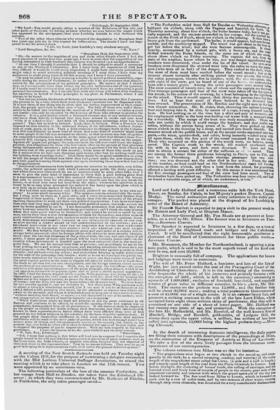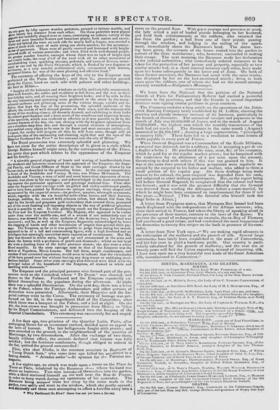In the dearth of interesting domestic intelligence, the daily papers
are tilling their columns with descriptions of the proceedings at Milan, on the coronation of the Emperor of Austria as King of Lo nbardy. Vie take a few of the more lively passages from the tiresome corre- spondence of our contemporaries.
The soletnn entrance into Milan was on the 1st instant— The preparations were begun at two otiuck in the moiniag, and co,. quentiy in the dark, by a careful sweeping, sanding, and watering of the enure length of the magnificent street called the Corso, (a mile and a half in length,) and a neatly equal length of the road from the Ports Orientate to Loreto. Long before daylight, the clattering of horses' hoofs, the rolling of carriages, and the hurried tread and lively hum of crowd. of people in the streets, gave note of the impatient curiosity and interest with which the grand 'pert tele of the day was looked forward to. The fine road from Milan to Loreto, which is boundetkes each side by a row of noble trees, and by two streams of clear water, running through deep stone channels, was decorated for a very considerable distance from
wee/Y•Pte by lofty square wooden pedestals, painted to imitate marble, and die til
abeet twenty feet distance from each other. On these pedestals were placed ei but tastefully shaped urns or vases, containing an infinite vatiety of the rigigare,-ti:ed most beautiful flowers and luxuriant plants, both native and exotic. -Veder and behind the trees on each side for nearly half-a-league, was erected a f sheds with rows of seats rising one above another, for the accommo- 7Tnooespectators. These were all partly covered and festooned with bright- doseed stuffs of various materials; and when filled with well-dressed people, the greater number females, amongst whom there wan no lack of bright eyes d comely the coup d'reil of the road with all its other accessories of a-a- c'o looks, „urstadowing trees, sparkling streams, pedestals, and vases of flowers, termi- „-i , at one end by the Porta Orientale, which is flanked by two doganos or to-ii.houses, in a very tasteful architectural style, ornamented with statues, 6cleptured friezes, &c. was of the most pleasing and effective kind.” The ceremony of offering the keys of the city to the Emperor was performed at the Portia Orientale ; and then ern: procession passed liking the Corso, lined on each side with palaces and other buildings, the best in Milan- i, imagine all the balconies and windows so richly and tastefully ornamented, filled wig' females, the nobler and wealthier in full dress, and the rest in their best bolyday suits, and all wearing their brightest looks; and if he adds to this the very interesting and animating scene produced in the street by the many. coloured uniforms and glittering arms of the various troops, cavalry and in- fantry, that kept the lime of the procession, the splendid uniforms of the officers, the crowds of well-dressed persons of both sexes, and the innumerable throng of the working classes, all decently dressed, and exhibiting in their looks the utmost good-humour and a keen sense of the wondrous and imposing beauty of the spectacle, which was rendered as effective as it was possible to be by the extreme fineness of the day, the sun shining with the brightest splendour from out s cloudless deep blue sky, and through a crystal clearness of atmosphere, that eaabled every object to be seen in its finest and most accurate outline,—if,
repeat, the reader will imagine all this, he will have some, though still an inadequate idea of the enchanting and cheering sight that met the eyes of the Emperor Ferdinand the First • on his entrance into the city of Milan." The Royal procession was extremely splendid and glittering. We bare not room for the entire description of it, given in a style which George Robins himself might envy, by the correspondent of the Times, but quote that part which relates to the appearance of the Emperor and his family-
" A tolerably general clapping of hands and waving of handkerchiefs from the windows and balconies announced the approach of the Emperor, the Impe- rial Family, and Great Officers of State in the state carriages, drawn by six 'horses each, as described in the preceding letter. In the carriage immediately in front of the Archduke and Viceroy Renier, was Prince Metternich. The Archduke and Viceroy, a man c.f mild and most benevolent expression of coun- tenance, was alone in his carriage ; and acknowledged in the most condescend- ing manner the particular applauses and greetings tendered him. Close after came the Imperial state carriage with its gilded and richly.emblazoned panels, said to have been painted by Rubens—its antique carvings, doine.aliaped roof turmounted by the imperial crown—its profuse, massive, silver-gilt ornaments, which, together with the six beautiful milk-white horses, and their harness, housings, saddles, acc. covered with crimson velvet, but almost hid from the sight by the lavish and gorgeous gold embroidery that covered them, presented one of the most dazzling and imposing objects in the way of' artificial splendour that it is possible to see. In this glittering coach sat the Emperor Ferdinand the First and his Empress Caroline. His Majesty, who appeared to be rather under than over the middle size, and of a serious if not melancholy east of features, was dressed in the white uniform of the Austrian line • his head was uncovered ; and he, as well as the Empress, frequently acknowledged by bows the clapping of hands and other testimonies of respect that greeted their pas- sage. The Empress, as far as it was possible to judge from seeing her seated, appeared to be of a tall and commanding figure, with a high forehead and an intelligent but seemingly somewhat stern expression of countenance. Her Ma- jesty was dressed in white satin, looped up and ornamented at the arms and about the bosom with a profusion of pearls and diamonds ; whilst on her head she wore a dazzling tiara of the latter precious atones; • she also wore a white blood mantilla. In the state carriage next to that of the Emperor was the widow of Napoleon, Maria Louisa. Her full form, ample countenance, and careless if not contented expression, would seem to indicate that the vicissitudes of life have passed over her without leaving any deep traces or saddening recol- lections behind. Some other state carriages that followed were filled with the principal ladies of the household of the Empress, all dressed in white and sparkling with diamonds."
The Emperor and the principal persons who formed part of the pro-
cession went to the Cathedral, where " Te Deum " was chanted, arid thence to the Palace. Ferdinand and the Empress repeatedly ex- kibited themselves to the populace during the afternoon. At night there was a splendid illumination. On the next day, there was a levee at the Palace, where the Foreign Ambassadors and other persons of distinction were presented. Afterwards, their Majesties and the Im- perial cortege %vent to the Corso. The ceremony of homage was per- formed on the 3d, in the magnificent Hall of the Caryatides after Which there was a banquet at the Palace, and a ball at night. On the 4th, the iron crown was brought in procession from Monza to Milan bpthe Royal Commissioners, and delivered into the keeping of the Imperial Chamberlain. This ceremony was excessively flat and stupid.



























 Previous page
Previous page